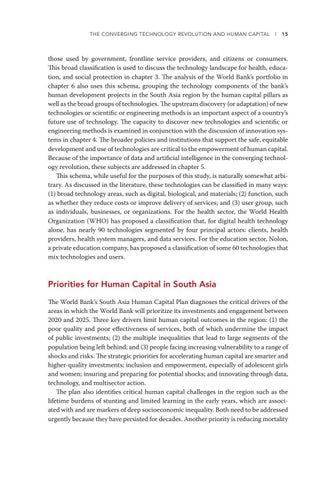The Converging Technology Revolution and Human Capital l 15
those used by government, frontline service providers, and citizens or consumers. This broad classification is used to discuss the technology landscape for health, education, and social protection in chapter 3. The analysis of the World Bank’s portfolio in chapter 6 also uses this schema, grouping the technology components of the bank’s human development projects in the South Asia region by the human capital pillars as well as the broad groups of technologies. The upstream discovery (or adaptation) of new technologies or scientific or engineering methods is an important aspect of a country’s future use of technology. The capacity to discover new technologies and scientific or engineering methods is examined in conjunction with the discussion of innovation systems in chapter 4. The broader policies and institutions that support the safe, equitable development and use of technologies are critical to the empowerment of human capital. Because of the importance of data and artificial intelligence in the converging technology revolution, these subjects are addressed in chapter 5. This schema, while useful for the purposes of this study, is naturally somewhat arbitrary. As discussed in the literature, these technologies can be classified in many ways: (1) broad technology areas, such as digital, biological, and materials; (2) function, such as whether they reduce costs or improve delivery of services; and (3) user group, such as individuals, businesses, or organizations. For the health sector, the World Health Organization (WHO) has proposed a classification that, for digital health technology alone, has nearly 90 technologies segmented by four principal actors: clients, health providers, health system managers, and data services. For the education sector, Nolon, a private education company, has proposed a classification of some 60 technologies that mix technologies and users.
Priorities for Human Capital in South Asia The World Bank’s South Asia Human Capital Plan diagnoses the critical drivers of the areas in which the World Bank will prioritize its investments and engagement between 2020 and 2025. Three key drivers limit human capital outcomes in the region: (1) the poor quality and poor effectiveness of services, both of which undermine the impact of public investments; (2) the multiple inequalities that lead to large segments of the population being left behind; and (3) people facing increasing vulnerability to a range of shocks and risks. The strategic priorities for accelerating human capital are smarter and higher-quality investments; inclusion and empowerment, especially of adolescent girls and women; insuring and preparing for potential shocks; and innovating through data, technology, and multisector action. The plan also identifies critical human capital challenges in the region such as the lifetime burdens of stunting and limited learning in the early years, which are associated with and are markers of deep socioeconomic inequality. Both need to be addressed urgently because they have persisted for decades. Another priority is reducing mortality

